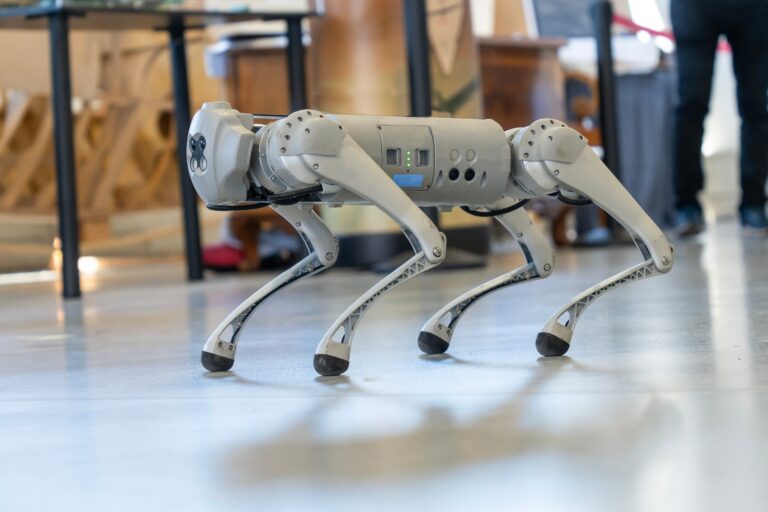As AI continues to advance, there is an ongoing debate about whether it can fully replace human security personnel. While AI-driven surveillance, access control, and threat detection have enhanced security capabilities, the reality is more nuanced. The future of security is not a choice between AI or humans but rather a hybrid approach where technology augments human abilities, making security operations more efficient and adaptive.
The Advantages of AI in Security Roles
AI is transforming the security industry by automating tasks, reducing human error, and providing continuous monitoring. These improvements offer significant benefits that improve overall security efficiency.
Key Advantages:
- 24/7 Surveillance and Monitoring: AI-powered cameras can process vast amounts of video footage in real time, identifying anomalies without fatigue or distraction.
- Predictive Threat Analysis: Machine learning algorithms detect patterns and predict potential threats before they materialise.
- Reduced Operational Costs: AI reduces the need for large security teams by handling repetitive tasks and automating monitoring.
- Faster Incident Response: AI-driven systems provide instant alerts, allowing security teams to respond rapidly to threats.
- Data-Driven Decision-Making: AI improves situational awareness by analysing trends and detecting risks that may go unnoticed by humans.
These capabilities enhance security effectiveness while allowing human personnel to focus on strategic decision-making and high-risk scenarios.
The Limitations of AI in Security Roles
Despite its advantages, AI has notable limitations that prevent it from fully replacing human security personnel.
Key Limitations:
- Lack of Human Intuition: AI cannot assess intent, emotional cues, or the subtleties of human behaviour that trained security personnel can interpret.
- False Positives and False Negatives: AI systems are prone to errors, flagging harmless activities as threats or failing to detect genuine risks.
- Cybersecurity Vulnerabilities: AI-driven security systems are susceptible to hacking, data manipulation, and adversarial attacks.
- Ethical and Legal Concerns: AI-driven surveillance raises privacy issues, and misidentification can lead to legal challenges.
- High Initial Costs and Maintenance: Implementing AI security infrastructure requires significant investment, along with ongoing updates and training to ensure accuracy.
While AI provides valuable support, human judgement remains crucial in evaluating situations that require adaptability and ethical considerations.
The Human-AI Hybrid Model: Enhancing Security Together
The most effective approach to security in 2025 and beyond is a human-AI hybrid model that maximises the strengths of both technology and personnel.
How AI Enhances Human Security Personnel:
- Augmenting Decision-Making: AI provides data-driven insights, helping security teams assess risks more effectively.
- Reducing Workload: AI automates repetitive monitoring tasks, allowing security officers to focus on complex investigations and threat response.
- Improving Response Time: AI alerts security teams instantly when a potential threat is detected, leading to faster reactions.
- Enhancing Situational Awareness: AI-powered analytics help security personnel understand evolving risks in real time.
- Assisting in Emergency Situations: AI-controlled robotics and drones can provide real-time intelligence in hazardous environments, reducing human exposure to danger.
Rather than replacing security personnel, AI strengthens their capabilities, leading to a more resilient and adaptive security infrastructure.
Industries Benefiting from the Hybrid Model
Many sectors are already adopting AI-powered security solutions while retaining human oversight.
Industries Leading AI Security Integration:
- Corporate Facilities: AI enhances visitor authentication, access control, and perimeter security.
- Airports & Transportation Hubs: AI-driven surveillance helps monitor crowds and detect suspicious behaviour.
- Retail & Commercial Spaces: AI analyses customer movement patterns to prevent theft and fraud.
- Critical Infrastructure: AI protects power plants, data centres, and government buildings from cyber and physical threats.
- Healthcare & Hospitals: AI monitors restricted areas and ensures patient safety while complementing security staff.
Across these industries, the combination of AI and human personnel delivers the most comprehensive security approach.
Challenges in Implementing AI-Human Security Models
While the hybrid model offers significant benefits, its implementation requires careful planning.
Key Challenges:
- Training Personnel to Work with AI: Security teams must understand AI tools and how to interpret their outputs.
- Regulatory and Compliance Considerations: AI-driven surveillance must align with data privacy laws and ethical guidelines.
- Cost of AI Deployment: While AI reduces long-term expenses, initial investment and ongoing maintenance can be high.
- Public Perception and Trust: Ensuring transparency in AI security practices is crucial for public acceptance.
Addressing these challenges ensures a smooth transition to AI-assisted security strategies.
Closing Note
AI is revolutionising security by automating tasks, improving surveillance, and enhancing threat detection. However, a hybrid model that integrates AI with human expertise is the most effective approach. By leveraging AI’s analytical power and automation alongside human intuition and judgement, organisations can create a security framework that is both adaptive and resilient.





